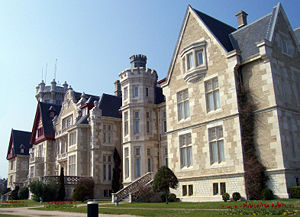
Palacio de la Magdalena
Encyclopedia

Spanish language
Spanish , also known as Castilian , is a Romance language in the Ibero-Romance group that evolved from several languages and dialects in central-northern Iberia around the 9th century and gradually spread with the expansion of the Kingdom of Castile into central and southern Iberia during the...
for Magdalena Palace) is an early 20th-century palace
Palace
A palace is a grand residence, especially a royal residence or the home of a head of state or some other high-ranking dignitary, such as a bishop or archbishop. The word itself is derived from the Latin name Palātium, for Palatine Hill, one of the seven hills in Rome. In many parts of Europe, the...
located on the Magdalena Peninsula
Magdalena Peninsula
The Magdalena Peninsula is a 69 acre peninsula located near the entrance to the Bay of Santander in the city of Santander, Cantabria along the north coast of Spain.The peninsula is a popular recreational destination for both tourists and locals...
of the city of Santander
Santander, Cantabria
The port city of Santander is the capital of the autonomous community and historical region of Cantabria situated on the north coast of Spain. Located east of Gijón and west of Bilbao, the city has a population of 183,446 .-History:...
, Cantabria
Cantabria
Cantabria is a Spanish historical region and autonomous community with Santander as its capital city. It is bordered on the east by the Basque Autonomous Community , on the south by Castile and León , on the west by the Principality of Asturias, and on the north by the Cantabrian Sea.Cantabria...
, Spain
Spain
Spain , officially the Kingdom of Spain languages]] under the European Charter for Regional or Minority Languages. In each of these, Spain's official name is as follows:;;;;;;), is a country and member state of the European Union located in southwestern Europe on the Iberian Peninsula...
.
History
Construction of the palace was initiated in 1908 by the local government of Santander for the purpose of providing a seasonal residence for the royal family of Spain. Funding was provided via popular subscription of the local populace.The design and construction of the palace were overseen by architect
Architect
An architect is a person trained in the planning, design and oversight of the construction of buildings. To practice architecture means to offer or render services in connection with the design and construction of a building, or group of buildings and the space within the site surrounding the...
s Javier González de Riancho and Gonzalo Bringas Vega, with construction completed in 1912. King Alfonso XIII and his family first arrived at the Palacio de la Magdalena on August 4, 1913, and returned annually to summer at the palace thru 1930. The royal family used the palace as a base for numerous recreational and sporting activities, and the king sometimes also held government meetings at the property. The annual trips ended with the proclamation of the Second Spanish Republic
Second Spanish Republic
The Second Spanish Republic was the government of Spain between April 14 1931, and its destruction by a military rebellion, led by General Francisco Franco....
in 1931.
Beginning in 1932, the palace was used to host summer courses through the Menéndez Pelayo International University
Menéndez Pelayo International University
The Menéndez Pelayo International University is a university with its centre in Madrid and branches in :*Santander*Valencia*Barcelona*Cuenca*Fundación Luis Seoane, La Coruña*Granada*Campus de Huesca de la Universidad de Zaragoza*Sevilla*Tenerife...
. The palace, which was declared an historical monument in 1982 and renovated between 1993 and 1995, continues to be used as a conference and meeting hall today. It is the most visited place in the city of Santander.
Design
The building has an eclectic style, combining EnglishArchitecture of the United Kingdom
The Architecture of England refers to the architecture practised in the territory of the present-day country of England, and in the historic Kingdom of England...
, French
French architecture
The history of French architecture runs in parallel with its neighbouring countries in Europe, with France being home to both some of the earliest pioneers in many architectural styles, and also containing some of the finest architectural creations of the continent.-Roman:The architecture of...
, and regional styles. It has two entrances, one on the north side for carriages, with a portico, and another to the south, which is the main entrance. The south entrance features two octagonal towers and double staircase tranches. The building is covered with stone masonry slate. The highlight of the interior is the reception rooms, which hold paintings of interest by artists such as Luis Benedito, Joaquín Sorolla y Bastida
Joaquín Sorolla y Bastida
Joaquín Sorolla y Bastida was a Valencian Spanish painter. Sorolla excelled in the painting of portraits, landscapes, and monumental works of social and historical themes...
, and Fernando Alvarez Sotomayor.
The stables were designed by Javier González de Riancho. They emulate a medieval English village with sharp roofs of steep slopes and wooden tiles. After summer courses were started, the stables were converted to student dormitories
Dormitory
A dormitory, often shortened to dorm, in the United States is a residence hall consisting of sleeping quarters or entire buildings primarily providing sleeping and residential quarters for large numbers of people, often boarding school, college or university students...
.
External links
- Palacio de la Magdalena Official Web Site, featuring photographs, maps, and virtual tours (English and Spanish)

